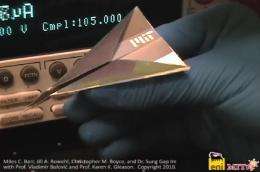January 4, 2011 weblog
Researchers print solar cells on toilet paper, other delicate materials (w/ Video)

To demonstrate how a new fabrication technique can print solar cells on extremely thin, flexible materials, researchers from MIT have patterned solar cells onto ordinary toilet paper. While toilet paper may be an unlikely substrate for practical solar cell applications, it illustrates the versatility of the technique for low-cost printing on a wide variety of materials.
Karen Gleason, a chemical engineering professor at MIT, along with graduate student Miles Barr and others, showed that the technique could be used to print solar cells on a variety of delicate materials. One example is rice paper, which is used to make spring rolls in restaurants and usually dissolves in wet processes. Since the researchers’ technique is a dry, solvent-free process, the rice paper remains intact. The researchers also demonstrated the technique on plastic Saran wrap, which repels water and would normally be difficult to coat.
The new method, called oxidative chemical vapor deposition (oCVD), involves spraying a vapor of a monomer and an oxidizing agent onto a substrate. The monomer and oxidizing agent polymerize when they meet and form PEDOT plastic. The plastic itself is conductive, but the conductivity can be further increased up to 1,000 times by controlling the substrate temperature so that small nanopores form, which can be laced with highly conductive silver particles.
The printed solar cells can also withstand a great deal of bending and stretching with minimal effect on their properties. In tests, the researchers bent a printed plastic substrate to a radius of less than 5 mm more than 1,000 times, and found that its efficiency was still 99% of what is was before bending. The electrodes could also be bent and stretched, and still retained their conductivity. To further demonstrate the method’s robustness, Barr folded a piece of paper printed with solar cells into a paper airplane, and showed that the device still generated a current.
MIT Professor Karen K. Gleason explains how graduate student Miles Barr folds a solar cell into a paper airplane. The research is part of the Eni-MIT Solar Frontiers Center. Video credit: MIT.
As the researchers noted, paper is not typically considered a good substrate for photovoltaics because it’s not transparent. However, the ability to print solar cells at low-cost on flexible, stretchable materials could be very useful for making solar cells more widespread. Since the technique can also be used to print other electronic devices besides solar cells, it could be used for novel applications such as printing electronics on fabric and other flexible displays.
More information: via: IEEE Spectrum
© 2010 PhysOrg.com



















